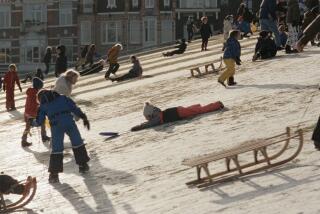City Fathers Strive to Present Another View of Dachau
- Share via
DACHAU, West Germany — The city fathers in this pleasant Bavarian city are trying to clean up the grim image that clings to it as the site of the most notorious concentration camp in Nazi Germany.
Before 1933, when the name Dachau became synonymous with horror, the town was locally famous for artists, who were attracted by the delicate light that suffused its hillside terraces, 20 miles north of Munich.
“After all,” Mayor Lorenz Reitmeier said in a recent interview, “our city is celebrating its 1,200th anniversary this year. We are 400 years older than Munich.
“We want to introduce Germans and foreign visitors to the real Dachau, the handsome city of 34,000, to tell them about its long history, and to place it in context. Most people have heard of Dachau only as a concentration camp.”
Reitmeier gazed out of the south window in his office, toward the towers of Munich in the distance and the snow-laden Bavarian Alps beyond, and added, “We think that 1,200 years of history should not be outweighed by the 12 years when the camp was here.”
Dachau Landscapes
Toward that end, the city has prepared a sumptuous coffee-table art book, with plates of the work of artists who painted here, most of them showing Dachau landscapes.
The paintings, filled with light, color and space, depict an idyllic southern Germany by dozens of artists. They include Hans Thonauer (circa 1521), Maximilian de Geer (1680-1768), Eduard Schleich (1812-74), Carl Spitzweg (1808-85), Dietrich Langko (1819-96), Paul Thiem (1858-1922), Ludwig Dill (1848-1940), Otto Struetzel (1855-1930), Lovis Corinth (1858-1925) and Max Liebermann (1847-1935).
“From 1870 to 1920, Dachau had the largest concentration of artists outside the big cities,” Reitmeier said. “We were famous throughout Germany.”
The city is preparing new brochures that list the various points of interest in the town: a Renaissance castle, built in 1558-73, that belonged to the Wittelsbach dynasty; various churches, including the onion-domed St. Jacob; civic buildings and city gates dating back 500 years; and the houses of the many artists who stayed here.
But the city fathers have faced up to the more recent past in their brochures by not excluding mention of the concentration camp, which lay east of the town. Through no fault of Dachau, Hitler’s SS chief, Heinrich Himmler, chose the area as the site of the first large concentration camp to hold political prisoners during the Nazi regime.
A Model for Others
The camp was set up as a model for others throughout the Reich and became infamous as a center for medical experimentation on prisoners.
The camp was liberated by Allied armies April 29, 1945, and its site has become a national memorial to the hundreds of thousands of prisoners who died or disappeared there. The camp was razed at the war’s end, but two of the 32 prisoners’ huts have been reconstructed according to the original interior layout.
A museum has been built in the administration building, giving visitors an idea of how the camps were designed and functioned. There are also Roman Catholic and Protestant chapels and a Jewish memorial.
A brochure issued to visitors says: “The City of Dachau, under whose name this horror became known to the world, bows in deep emotion to the hundreds of thousands of prisoners and the many dead. The inhabitants of Dachau . . . see in the memorial a warning against the inhumanity of the Nazi system. They demand, as do all men of good will, that such terror never again will be repeated anywhere.”
The note adds: “To equate the Concentration Camp Dachau with the City of Dachau would be unjust.”
Most Dachauers tend to ignore the existence of the grim memorial on their outskirts.
“We try not to notice it,” one younger resident said. “We would have liked to see it all wiped out.”
More to Read
Sign up for The Wild
We’ll help you find the best places to hike, bike and run, as well as the perfect silent spots for meditation and yoga.
You may occasionally receive promotional content from the Los Angeles Times.






